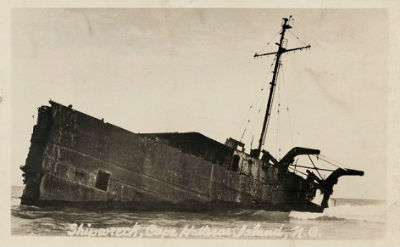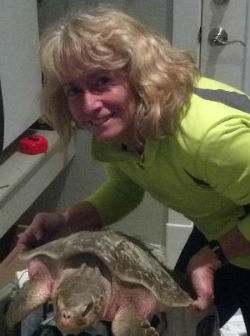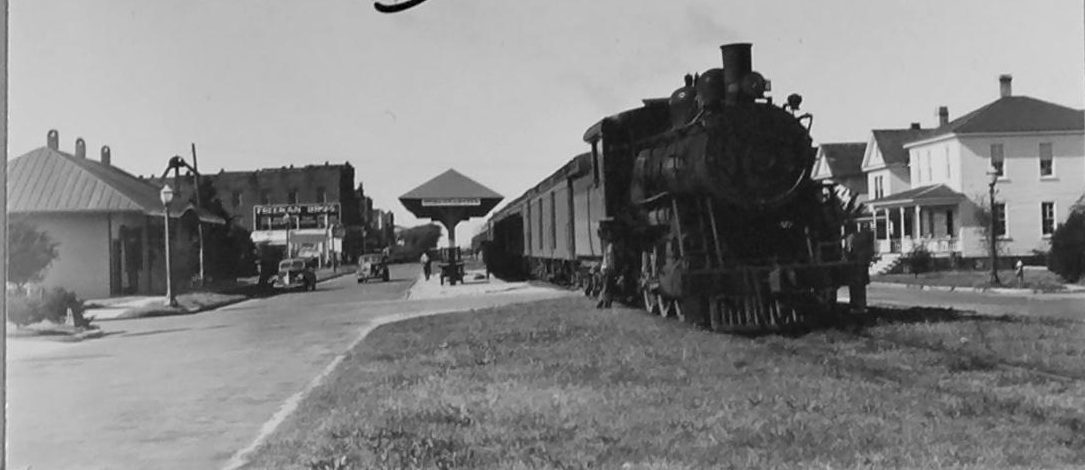By Jordan Tomberlin and Irene Nolan
Reprinted from The Island Free Press
HATTERAS — After years of planning and preparation, construction has begun on the ambitious Hatteras Island Ocean Center project in Hatteras village.
Supporter Spotlight
And according to Eric Kaplan, the driving force behind the Ocean Center, the first phase of development, which will include an information center and a series of wetland trails that lead to a soundfront launching area, will be completed and open to the public sometime this spring.
The main feature of this initial phase will be the multi-purpose information and education center. It will be housed in the former Beacon Shops building, just off N.C. 12 in the village, which the Ocean Center bought last year. It will serve as the headquarters for the non-profit Ocean Center and an interactive, educational resource for visitors.
Kaplan and a network of volunteers have been hard at work, remodeling one of the building’s vacated retail spaces and preparing to outfit it with an array of exhibits and interactive technologies that will allow visitors to explore the complexity and diversity of the island’s ecosystem.
 Shipwrecks will be a featured exhibit at the Hatteras Island Ocean Center. This unidentified wreck on Hatteras Island appeared on a postcard, circa 1929. Photo: Durwood Barbour Collection of N.C. Postcards, N.C. Collection at the University of North Carolina at Chapel Hill |
“Everything we do in this building is going to be tied to ecology, in one way or another,” Kaplan said. “And because we’re small, we have to be very, very creative.”
To that end, Kaplan and volunteers Lee Haller, Jody Haller, and Lee Setkowsky have organized the space into a series of exhibits—each focusing on a particular aspect of the island ecosystem—that rely heavily on visual media and interactive technologies to engage visitors.
Supporter Spotlight
When visitors first enter the space, they will be greeted by a large — as in, life-sized — video screen that will feature the underwater photography of local artist Russell Blackwood.
From there, visitors will move to an exhibit on marine life and the ecology of shipwrecks, which will be created in collaboration with the Graveyard of the Atlantic Museum, and will, of course, feature everyone’s favorite ocean predator, the shark.
Next up is a feature on weather and its role in the island’s ecosystem, followed by an exhibit on shellfish and salt marsh ecology.
From there, visitors will enter what Haller affectionately called “Turtle Land.”
As Kaplan put it, “everyone loves turtles.” And, he added, “Turtles play a really important part in what’s going on here.”
The first stop in “Turtle Land” in an interactive machine, on loan from the N.C. Aquariums, which simulates x-rays and probes and allows users to “diagnose” turtle maladies and learn how to care for them. Basically, it teaches visitors about sea turtle biology and the environmental conditions that affect turtles by allowing the visitors to play veterinarian.
Another exhibit focuses exclusively on N.C. sea turtles, with a particular emphasis on the issues and opportunities facing Hatteras Island. The exhibit will include information about the nesting, stranding, rehabilitation, release of turtles and information about the relationship between turtles and fishermen on Hatteras Island.
The latter provides a natural segue into the final exhibit, which will provide information about fishing on Hatteras Island—and Hatteras village especially.
Like the exhibit on shipwreck ecology, the fishing exhibit will be the product of collaboration between Ocean Center volunteers and The Graveyard of the Atlantic Museum, with special input from Ernie Foster, captain of the Albatross Fleet, the island’s oldest charter fishing enterprise, which was started by his father in 1937.
The exhibit will focus specifically on the charter and commercial fishing industries, but Haller and Kaplan said they hope in the future to include information about beach and pier fishing as well.
As they come full circle, just before they reach the main entrance of the space, visitors will see an interactive whiteboard that will provide information about what’s happening on the island that day—including weather and tide updates—as well as an area where visitors can pick up brochures, cards, and other information from local businesses.
And, of course, there will be a small gift shop, where visitors will be able to purchase a few Ocean Center goods should they feel so inclined.
After they leave the information and education center, visitors can feel free to enjoy the other Ocean Center feature that will be available this spring — the nature trials that will snake through wetlands behind the Ocean Center building, leading visitors to the Pamlico Sound.
Essentially, the trails will be little more than well-beaten footpaths through the marsh.
“We’re restricting ourselves to no hardened structures,” Haller said of the trails. “We want to make as little impact as possible.”

The Hatteras Island Ocean Center’s education center and ecology park should be open this spring and will provide exhibits and access to creeks and wetlands for hiking and watersports. Photo: Lix Browning Fox, Island Free Press
The idea is that the trails will function as a kind of hands-on, outdoor educational experience—that visitors will be able to immerse themselves in the wetland ecosystem in a minimally invasive way.
In addition to the trails themselves, the Ocean Center is planning to provide a space for visitors to launch watersports equipment at the trails’ end.
They plan to create some sort of unloading dock for the equipment, but for now, those details—as well as details about the parking situation—are still up in the air. Kaplan insisted, though, that sometime this spring there would be free, public kayak and stand-up paddleboard access and accessible parking, for anyone who wanted to explore the Hatteras wetlands.
That’s exciting news for anyone trying to launch a kayak or a paddleboard in Hatteras village, since there is currently a dearth of public launching areas, and parking is even harder to come by.
However, despite his commitment to facilitating responsible wetland excursions, Kaplan was adamant that providing public access would be as far as the Ocean Center would go. In other words, the Ocean Center would not be offering training courses, equipment rentals, guided tours or other watersports-related services.
“We’re not trying to compete with [local businesses],” Kaplan said. “Our job is to enhance. We’re all about economic development, not about hurting the economy.”
The idea that the Ocean Center will be a boon to the local economy and bolster local businesses is one that’s very important to Kaplan—and one to which he’s very committed.
There will be no charge to visit the Ocean Center and use its facilities. “We hope that [visitors] have such a good experience that they’ll give us a donation,” Kaplan said.
And local businesses will be able—and are encouraged to—place flyers, brochures, and business cards in the education center.
The long-term plan for the Hatteras Island Ocean Center goes beyond the education center and the soundside trails and water access. The Ocean Center’s first move was to purchase property on the oceanside of N.C. 12 in Hatteras village, the site of the former General Mitchell Motel that was destroyed in Hurricane Isabel in 2003.
 Jody Haller, a volunteer at the center, rescued this Kemp’s ridley sea turtle in January. Photo: Hatteras Island Ocean Cener |
The facilities on the oceanside, Kaplan hopes, will eventually include a world-class fishing pier, a pier house with an event venue, a restaurant for oceanview dining, other food vendors, covered playground, an arcade, plentiful parking, a public bathhouse, tackle shop, equipment rental, indoor and outdoor exhibits, classrooms, research areas and a wildlife rehabilitation area.
Kaplan sees locals and visitors using the area for fishing, swimming, surfing, kiteboarding, windsurfing, standup paddleboarding, scuba diving, bird watching, stargazing, wintertime seal and whale watching, dining, enjoying live music and just sitting and watching the sunrises and sunsets.
It will be, he says, “a place for everybody to enjoy the ocean, play, learn, and have fun.”
However, while Kaplan and the Ocean Center board pursue funding possibilities for the oceanside phase of the project, they are opening up the information and ecology center to give the project a presence on the island.
And the soundside trails and launching area are much less expensive to develop than the oceanside phase.
That phase, Kaplan says, is several years down the road at least and will involve building the pier house first and then the pier. The thought behind that is that local businesses leasing areas in the pier house would provide a source of income.
Over the winter, the Ocean Center received what is essentially the National Park Service’s endorsement for the project. The Memorandum of Intent between the Cape Hatteras National Seashore and the Ocean Center gives the center permission for a portion of the pier to cross park property on the beach. The Pier House would be on the private land, purchased by the ocean center.
To accomplish this, the Park Service will enter into a cooperative management agreement with Dare County for operation and maintenance of the portion of the center crossing seashore property. However, the Park Service will have no financial liability for the Ocean Center, and thus far Dare County has made no financial commitments to the project.
Kaplan is pursuing financing through grants from the public and private sector, including foundations, to build the project.
Kaplan hopes that the Ocean Center will be a draw for visitors—a facility that will attract more people to Hatteras village. “We want people to realize that the lower part of Hatteras is a destination in its own right, not a way to get to Ocracoke.”
Kaplan also believes that the Ocean Center will complement the island’s existing cultural and historical attractions—including the lighthouse, the marinas and the Graveyard of the Atlantic Museum—and that the attractions will support and bolster one another.
“I think it all works together, and that’s—I think—an important aspect of what we’re doing. You have to make this work, not only from a cultural point of view, but also economically,” Kaplan said. “If there isn’t enough stuff to do, people won’t go. So, the more things [to do], the better. They actually reinforce each other.”







